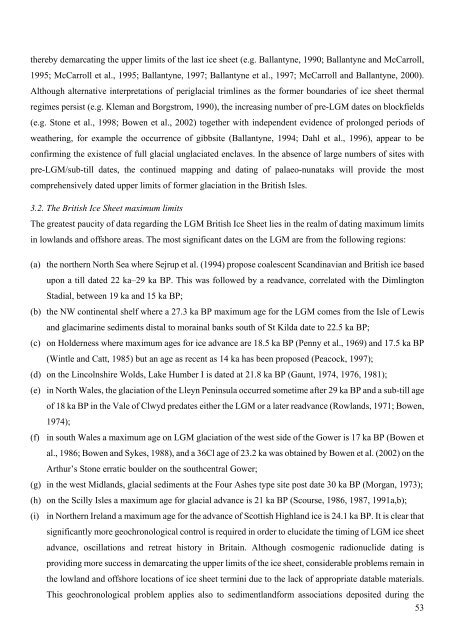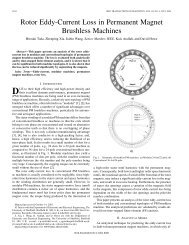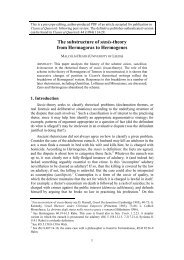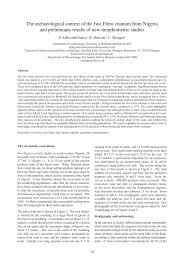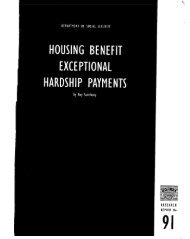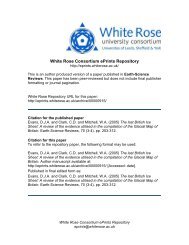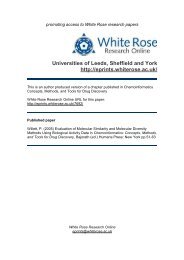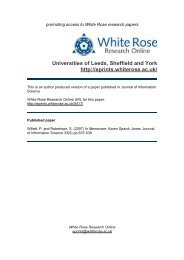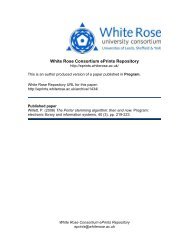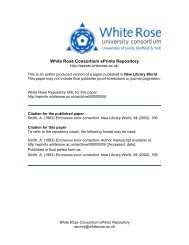The last British Ice Sheet: A review of the evidence utilised in the ...
The last British Ice Sheet: A review of the evidence utilised in the ...
The last British Ice Sheet: A review of the evidence utilised in the ...
You also want an ePaper? Increase the reach of your titles
YUMPU automatically turns print PDFs into web optimized ePapers that Google loves.
<strong>the</strong>reby demarcat<strong>in</strong>g <strong>the</strong> upper limits <strong>of</strong> <strong>the</strong> <strong>last</strong> ice sheet (e.g. Ballantyne, 1990; Ballantyne and McCarroll,<br />
1995; McCarroll et al., 1995; Ballantyne, 1997; Ballantyne et al., 1997; McCarroll and Ballantyne, 2000).<br />
Although alternative <strong>in</strong>terpretations <strong>of</strong> periglacial triml<strong>in</strong>es as <strong>the</strong> former boundaries <strong>of</strong> ice sheet <strong>the</strong>rmal<br />
regimes persist (e.g. Kleman and Borgstrom, 1990), <strong>the</strong> <strong>in</strong>creas<strong>in</strong>g number <strong>of</strong> pre-LGM dates on blockfields<br />
(e.g. Stone et al., 1998; Bowen et al., 2002) toge<strong>the</strong>r with <strong>in</strong>dependent <strong>evidence</strong> <strong>of</strong> prolonged periods <strong>of</strong><br />
wea<strong>the</strong>r<strong>in</strong>g, for example <strong>the</strong> occurrence <strong>of</strong> gibbsite (Ballantyne, 1994; Dahl et al., 1996), appear to be<br />
confirm<strong>in</strong>g <strong>the</strong> existence <strong>of</strong> full glacial unglaciated enclaves. In <strong>the</strong> absence <strong>of</strong> large numbers <strong>of</strong> sites with<br />
pre-LGM/sub-till dates, <strong>the</strong> cont<strong>in</strong>ued mapp<strong>in</strong>g and dat<strong>in</strong>g <strong>of</strong> palaeo-nunataks will provide <strong>the</strong> most<br />
comprehensively dated upper limits <strong>of</strong> former glaciation <strong>in</strong> <strong>the</strong> <strong>British</strong> Isles.<br />
3.2. <strong>The</strong> <strong>British</strong> <strong>Ice</strong> <strong>Sheet</strong> maximum limits<br />
<strong>The</strong> greatest paucity <strong>of</strong> data regard<strong>in</strong>g <strong>the</strong> LGM <strong>British</strong> <strong>Ice</strong> <strong>Sheet</strong> lies <strong>in</strong> <strong>the</strong> realm <strong>of</strong> dat<strong>in</strong>g maximum limits<br />
<strong>in</strong> lowlands and <strong>of</strong>fshore areas. <strong>The</strong> most significant dates on <strong>the</strong> LGM are from <strong>the</strong> follow<strong>in</strong>g regions:<br />
(a) <strong>the</strong> nor<strong>the</strong>rn North Sea where Sejrup et al. (1994) propose coalescent Scand<strong>in</strong>avian and <strong>British</strong> ice based<br />
upon a till dated 22 ka–29 ka BP. This was followed by a readvance, correlated with <strong>the</strong> Diml<strong>in</strong>gton<br />
Stadial, between 19 ka and 15 ka BP;<br />
(b) <strong>the</strong> NW cont<strong>in</strong>ental shelf where a 27.3 ka BP maximum age for <strong>the</strong> LGM comes from <strong>the</strong> Isle <strong>of</strong> Lewis<br />
and glacimar<strong>in</strong>e sediments distal to mora<strong>in</strong>al banks south <strong>of</strong> St Kilda date to 22.5 ka BP;<br />
(c) on Holderness where maximum ages for ice advance are 18.5 ka BP (Penny et al., 1969) and 17.5 ka BP<br />
(W<strong>in</strong>tle and Catt, 1985) but an age as recent as 14 ka has been proposed (Peacock, 1997);<br />
(d) on <strong>the</strong> L<strong>in</strong>colnshire Wolds, Lake Humber I is dated at 21.8 ka BP (Gaunt, 1974, 1976, 1981);<br />
(e) <strong>in</strong> North Wales, <strong>the</strong> glaciation <strong>of</strong> <strong>the</strong> Lleyn Pen<strong>in</strong>sula occurred sometime after 29 ka BP and a sub-till age<br />
<strong>of</strong> 18 ka BP <strong>in</strong> <strong>the</strong> Vale <strong>of</strong> Clwyd predates ei<strong>the</strong>r <strong>the</strong> LGM or a later readvance (Rowlands, 1971; Bowen,<br />
1974);<br />
(f) <strong>in</strong> south Wales a maximum age on LGM glaciation <strong>of</strong> <strong>the</strong> west side <strong>of</strong> <strong>the</strong> Gower is 17 ka BP (Bowen et<br />
al., 1986; Bowen and Sykes, 1988), and a 36Cl age <strong>of</strong> 23.2 ka was obta<strong>in</strong>ed by Bowen et al. (2002) on <strong>the</strong><br />
Arthur’s Stone erratic boulder on <strong>the</strong> southcentral Gower;<br />
(g) <strong>in</strong> <strong>the</strong> west Midlands, glacial sediments at <strong>the</strong> Four Ashes type site post date 30 ka BP (Morgan, 1973);<br />
(h) on <strong>the</strong> Scilly Isles a maximum age for glacial advance is 21 ka BP (Scourse, 1986, 1987, 1991a,b);<br />
(i) <strong>in</strong> Nor<strong>the</strong>rn Ireland a maximum age for <strong>the</strong> advance <strong>of</strong> Scottish Highland ice is 24.1 ka BP. It is clear that<br />
significantly more geochronological control is required <strong>in</strong> order to elucidate <strong>the</strong> tim<strong>in</strong>g <strong>of</strong> LGM ice sheet<br />
advance, oscillations and retreat history <strong>in</strong> Brita<strong>in</strong>. Although cosmogenic radionuclide dat<strong>in</strong>g is<br />
provid<strong>in</strong>g more success <strong>in</strong> demarcat<strong>in</strong>g <strong>the</strong> upper limits <strong>of</strong> <strong>the</strong> ice sheet, considerable problems rema<strong>in</strong> <strong>in</strong><br />
<strong>the</strong> lowland and <strong>of</strong>fshore locations <strong>of</strong> ice sheet term<strong>in</strong>i due to <strong>the</strong> lack <strong>of</strong> appropriate datable materials.<br />
This geochronological problem applies also to sedimentlandform associations deposited dur<strong>in</strong>g <strong>the</strong><br />
53


